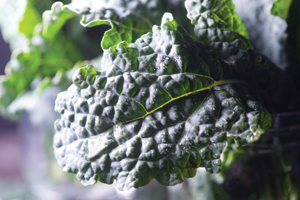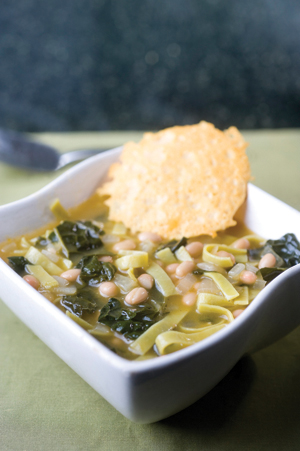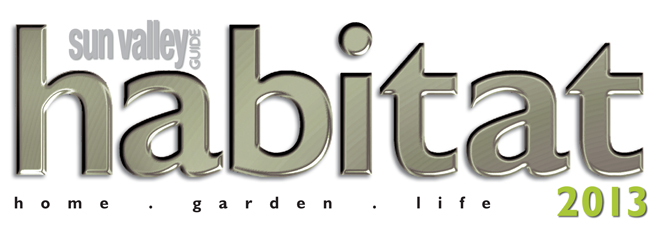
eat it
kale: the celebrity cabbage
Cheryl Sternman Rule, food blogger and author of RIPE: A Fresh, Colorful Approach to Fruits and Vegetables, delves into the newest super-hyped super-food.
photos by Paulette Phlipot
A few years ago you'd be hard pressed to find mainstream kale enthusiasts. Sure, health food junkies and vegetarians have known about this superfood for years, but your average Joe and Jane wouldn't touch the stuff with a 10-foot pole.
So, what changed? For one, kale chips—made by drying out stemmed, oiled kale leaves in a low oven and sprinkling them liberally with salt—gave these healthful greens a new grab-and-go convenience (and crunch) and catapulted them into the populist realm. In addition, dark green foods as a broad category began to enjoy greater attention from health writers, dietitians and even chefs due to their high nutrient density, bold color and culinary versatility. Suddenly, kale, with its newfound cachet, was everywhere.
Technically and botanically speaking, kale is a member of the cabbage family, a brassica like broccoli, cauliflower and Brussels sprouts. Rich in vitamins A and C, as well as iron and calcium, it's not just a nutrient powerhouse, it's also cold tolerant and therefore a good candidate for growing here in the Wood River Valley.
Farmer Judd McMahan, owner of Wood River Organics, says, "You have to have a certain amount of fertility in your soil to get a full healthy leaf of kale." He grows bunch kale, like the kind you'd find in the supermarket, and also a baby kale mix, which is so popular and in such high demand that he has swapped it in for the leafy spinaches he used to grow. "We've grown kale every year for 10 years and all of a sudden, two years ago, we couldn't grow enough of it," McMahan says. Kale's popularity doesn't seem to be ebbing, in other words.
If you're interested in growing your own kale, McMahan advises planting three separate sowings beginning in the spring, to be harvested between summer and late fall. "If you have a cold frame," he adds, "you can extend the season. It won't grow from November 15 to February 15 due to the lack of light, but you can still harvest during that time."
Once you've harvested your kale, get creative with it in the kitchen. I like to toss kale in soups (see sidebar), substitute it for romaine in Caesar salads, and juice it with green apples, grapes, mint and pineapple in a juicer or high-speed blender. Massaging its (raw) leaves with olive oil and something acidic—lemon juice preferably, but vinegar would work, too—helps break down the cell walls and tenderize it. "Kale is a thick-leaved, thick cell-walled plant," McMahan explains, "so by massaging it and using acid like you would with ceviche, you're breaking it down and 'cooking' it a little bit."
"Oh! One more thing," he adds, his voice excited. "Kale and eggs. Sauté a little kale with your scrambled eggs. It's like the best thing going!" Spoken like a true believer. |
Green noodle soup with kale, beans and parmesan crisps
This beautiful, green-laden soup showcases dark and healthful lacinato kale, which may also be called Tuscan, black or dinosaur kale. Parmesan rounds provide a chewy bite, and crushed red pepper lends a warming kick.
SERVES 6
• 2 tablespoons extra-virgin olive oil
• 1 small onion, diced
• ½ medium fennel bulb (no fronds), cored and diced
• 2 garlic cloves, minced
• ¼ teaspoon crushed red pepper
• Kosher salt and freshly ground black pepper
• 4 cups vegetable stock
• 2 bunches lacinato kale (about ¾ pound or 340g)
• 1 (15-ounce, or 450g) can navy or cannellini beans,
drained and rinsed
• 4 ounces (115g) spinach linguini or fettuccini,
broken into 2-inch lengths
• 1½ cups (120g) coarsely shredded Parmesan cheese
(about 2 ounces) divided

• In a large saucepot or Dutch oven, heat the oil over medium heat. Add the onion, fennel, garlic, crushed red pepper, ¾ teaspoon salt, and ½ teaspoon black pepper. Sauté, stirring occasionally, until the vegetables soften and begin to brown, 8 to 10 minutes. Add the stock and 3 cups water. Bring to a boil.
• Meanwhile, strip the kale leaves by "unzipping" them with a downward motion. Roughly chop the leaves (discard the stalks). Add the kale, beans and linguini to the pot. When the soup returns to a boil, lower the heat to medium and simmer until the pasta is tender, 8 to 15 minutes, depending on the type and brand.
• While the soup cooks, make the Parmesan crisps. Heat a large, nonstick skillet over medium heat. For each crisp, drop 2 tablespoons of cheese into a little mound, making 6 rounds total. Cook the crisps undisturbed for about 5 minutes, or until they bubble, brown, and begin to solidify. Flip with a thin spatula and cook the other side 2 minutes longer. Remove the skillet from the heat, and let the crisps harden completely.
• Stir half of the remaining cheese into the soup. Adjust seasonings (you'll need about 1 teaspoon more salt and plenty of pepper). Divide among six bowls, floating one Parmesan crisp in each. Pass the remaining cheese at the table.
Recipe reprinted with permission from RIPE © 2012 by Cheryl Sternman Rule, Running Press, a member of the Perseus Book Group. Photography © 2012 by Paulette Phlipot. |


